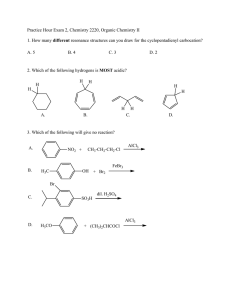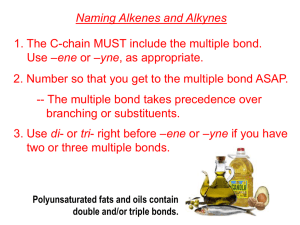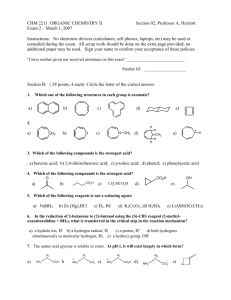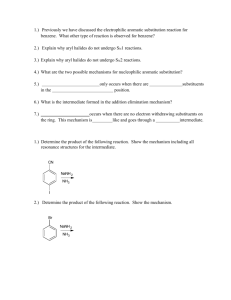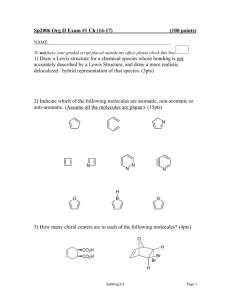Second practice hour exam, Chemistry 2220, Organic Chemistry II
advertisement
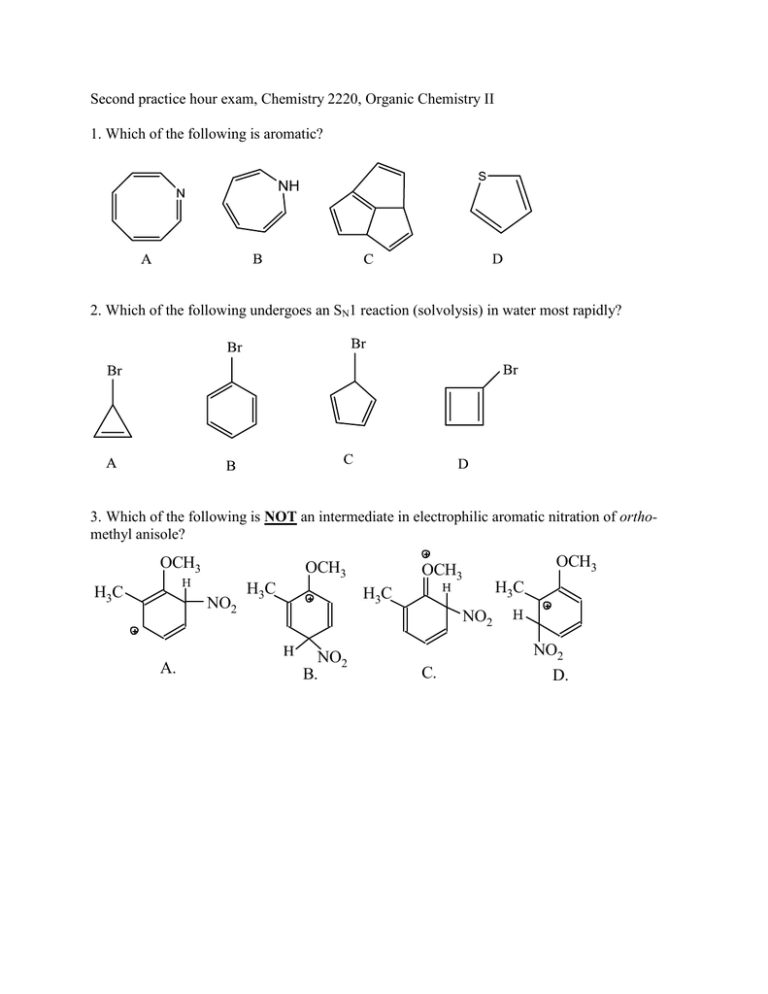
Second practice hour exam, Chemistry 2220, Organic Chemistry II 1. Which of the following is aromatic? 2. Which of the following undergoes an SN1 reaction (solvolysis) in water most rapidly? 3. Which of the following is NOT an intermediate in electrophilic aromatic nitration of orthomethyl anisole? OCH3 H3C NO2 A. H3C OCH3 OCH3 H3C OCH3 H3C NO2 NO2 B. C. NO2 D. 4. Which of the following is likely to be the first step in the general mechanism for electrophilic aromatic substitution reactions? 5. Which of the following reagents is used to carry out the transformation shown? A. LiAlH4 B. NaBH4 C. H2/Pt D. (i-Bu)2AlH 6. Which of these is the best way to synthesize 2,2-dimethyl-3-hexene? A. (CH3)3CCl with Ph3P, then NaNH2, then butanal B. (CH3)3CCH2Cl with Ph3P, then NaNH2, then propanal C. tert-butyl chloride and butanal with hot KMnO4, heat, hydroxide D. neopentyl bromide and propanal with O3, then CH3SCH3 7. Which of the following proceeds the slowest? 8. Which of the following is m-nitrobenzoic acid 9. What would you use to synthesize toluene from benzaldehyde? A. H2, Ni B. KMnO4, hydroxide, heat C. Zn(Hg), HCl D. NaBH4 10. The product Z of the following reaction series is 11. What is needed to complete this reaction? A. (CH3)2CHCH2MgBr B. (CH3)2CHCH2Br C. CH3CH2CH(CH3)MgBr D. CH3CH2CH(CH3)Br 12. What is the IUPAC name of this compound? HC≡CCH2CH2CH=O A. 4-pentynal B. 4-pentynone C. 1-pentyn-5-al D. 1-pentyn-5-one 13. How many double bonds are present in a resonance structure of triphenylene? A. 6 B. 7 C. 8 D. 9 14. Which of the following is the structure of aniline? O OH NH2 S A. B. C. O D. O O 15. Which is the product of the reaction between toluene and bromine in presence of FeBr3? Br Br A. B. Br D. C. Br 16. Which of these is the best way to synthesize meta-nitrobenzoic acid from benzene? A. HNO3/H2SO4, then CH3Cl/AlCl3, then hot KMnO4 B. HNO3/H2SO4, then CH3C(=O)Cl/AlCl3, then hot KMnO4 C. CH3Cl/AlCl3, then HNO3/H2SO4, then hot KMnO4 D. CH3C(=O)Cl/AlCl3, then hot KMnO4, then HNO3/H2SO4 17. What is a major organic product of the following reaction? CH3 NO2 HNO3 H2SO4 D. C. B. A. NO2 NO2 NO2 NO2 CH3 CH3 CH3 CH3 O2N NO2 SO3H NO2 18. Which one does not react with H2CrO4, but has an IR band at 1720 cm-1 and a 1H NMR signal at 9.5ppm? A. B. C. D. 19. What is the major product of the following reaction? O CH3OH H OH OH A. B. H OCH3 OH H OCH3 D. C. H H 20. Which of these statements is false, comparing benzene to 1,3,5-hexatriene? A. Benzene requires a Lewis acid catalyst to react with Br2; 1,3,5-hexatriene does not. B. The shortest CC bond length is in 1,3,5-hexatriene rather than benzene. C. 1,3,5-hexatriene tends to undergo addition reactions while benzene tends to undergo substitutions. D. Hydrogenation of benzene releases more energy than expected, compared to 1,3,5-hexatriene. 21. Which of the following is the electrophile in the electrophilic aromatic nitration of benzene? A. NO3- B. NO2+ C. N2 D. NH3 22. Which of these compounds gives the slowest reaction (including no reaction) with CH3Cl/AlCl3? SO3H A. CH3 B. C. Br D. 23. omit 24. Identify the major product of the following reaction: O H + NH2 N H NH2 A. H B. N O N H C. D. N CH N H NH2 O N H 25. Which of these procedures does not form a ketone as the final product? A. Corey-House reaction of an acid chloride + lithium dialkyl cuprate B. Hydration of an alkyne C. Friedel-Crafts acylation D. Oxidation of a tertiary alcohol
